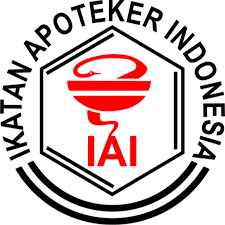Economic Losses of Unused Medicines Among Households in Grobogan Regency
Indriyati Hadi Sulistyaningrum(1*), Arifin Santoso(2), Fildza Huwaina Fathnin(3), Atmarulin Dewi Nugrahaini(4), Erki Arfianto(5), Herlisa Maulidina(6)(1) Bagian Farmasi Klinik dan Komunitas program studi farmasi Universitas Islam Sultan agung
(2) Department of Pharmacy, Faculty of Medicine, Sultan Agung Islamic University, Semarang, Indonesia
(3) Department of Pharmacy, Faculty of Medicine, Sultan Agung Islamic University, Semarang, Indonesia
(4) Department of Pharmacy, Faculty of Medicine, Sultan Agung Islamic University, Semarang, Indonesia
(5) Department of Pharmacy, Faculty of Medicine, Sultan Agung Islamic University, Semarang, Indonesia
(6) Department of Pharmacy, Faculty of Medicine, Sultan Agung Islamic University, Semarang, Indonesia
(*) Corresponding Author
Abstract
Keywords
Full Text:
PDFReferences
AlSamanhodi, H., Meshary, A., Kwame, A., Saleh, A., Abdulmalik, A., Shmeylan, A., Maha, A., Salah, A., and Abdulkareem, A., 2017. Evaluation of The Causes and Cost Impact of Returned Intravenous Medications at A Tertiary Care Hospital in Riyadh, Saudi Arabia. Tropical Journal of Pharmaceutical Research January, 16(1), 231-237. https://doi.org/10.4314/tjpr.v16i1.31
Amani S. Abushanaba, Waleed M. Sweilehb, & Mayyada W., 2013. Storage and Wastage of Drug Products in Jordanian Households: A Cross-Sectional Survey. International Journal of Pharmacy Practice. 21(3), 185-191. https://doi.org/10.1111/j.2042-7174.2012.00250.x
Asnasari, L., 2017. Hubungan Pengetahuan tentang Swamedikasi dengan Pola Penggunaan Obat pada Masyarakat Dusun Kenaran, Sumberharjo, Prambanan, Sleman, Yogyakarta. Skripsi Fakultas Farmasi Universitas Sanata Dharma Yogyakarta, 1-54.
Azad, M.A.K., Ansary, M.R.H., Akhter, M.A., Al-Mamun, S.M.M., Uddin, M., & Rahman, M.M., 2012. Disposal Practice for Unused Medications among The Students of The International Islamic University Malaysia. Journal of Applied Pharmaceutical Science, 2(7), 101-106. https://doi.org/10.7324/JAPS.2012.2712
BPS Jateng, 2019. Profil Kesehatan Provinsi Jawa Tengah Tahun 2019. Badan Pusat Statistik Provinsi Jawa Tengah, Jawa Tengah. https://jateng.bps.go.id/publication/2020/06/04/7cc72f7ad0473a35c595f0de/profil-kesehatan-provinsi-jawa-tengah-2019.html
Edi, I.M.S., 2020. Factors Affecting The Patient Adherenceto Medical Treatment: A Systematic Review. Jurnal Ilmiah Medicamento, 1(1), 1–8. https://doi.org/10.36733/medicamento.v1i1.719
Fatony R.F., 2017. Analisis Biaya Obat Tidak Terpakai Pada Mahasiswa Fakultas Farmasi Universitas Muhammadiyah Surakarta. Skripsi Fakultas Farmasi Universitas Muhammadiyah Surakarta, 1-20.
Ismail, I., 2015. Faktor Yang Mempengaruhi Keputusan Masyarakat Memilih Obat Tradisional di Gampong Lam Ujong. Idea Nursing Journal, 6(1), 7–14. https://core.ac.uk/download/pdf/292076463.pdf
Kemenkes RI., 2016. Peraturan Menteri Kesehatan Republik Indonesia Nomor 74 Tahun 2016 Tentang Standar Pelayanan Kefarmasian di Puskesmas. Kementerian Kesehatan Republik Indonesia, Jakarta. https://farmalkes.kemkes.go.id/unduh/permenkes742016standar-pelayanan-kefarmasian-di-puskesmas/
Khariyati, L., 2013. Faktor yang Berhubungan dengan Penyimpanan Obat Keras dan Obat Antibiotika Tanpa Resep di Provinsi Gorontalo (Analisis Data Riskesdan 2013). Jurnal Publikasi Kesehatan Masyarakat Indonesia, 2(1), 13–19. https://ppjp.ulm.ac.id/journal/index.php/JPKMI/article/view/2704/2354
Lisni, I., Anggriani, A., & Puspitasari, R., 2020. Kajian Peresepan Obat Antihistamin Pada Pasien Rawat Jalan disalah satu Rumah Sakit di Bandung. Jurnal Riset Kefarmasian Indonesia, 2(2), 52–62. https://doi.org/10.33759/jrki.v2i2.77
Naufal, M., Melviani, M., & Riduansyah, M., 2021. Estimasi Nilai Ekonomi Obat Bebas Tidak Digunakan pada Kalangan Rumah Tangga Kecamatan Banjarmasin Timur. Journal Pharmaceutical Care and Sciences, 2(1), 15–22. https://doi.org/10.33859/jpcs.v2i1.131
PP IAI. (2014). Pedoman Pelaksanaan Gerakan Keluarga Sadar Obat. Pengurus Pusat Ikatan Apoteker Indonesia, Jakarta. https://adoc.pub/pp-iai-2014-pedoman-pelaksanaan-gerakan-keluarga-sadar-obat-.html
Ridwan, B. A., Kristina, S. A., & Wiedyaningsih, C., 2019. Economic Value Estimation of Unused Medicines Among Households in Yogyakarta City. Journal of Management and Pharmacy Practice, 9(3), 174-181. https://doi.org/10.22146/jmpf.42984
Rikomah, S.E., 2016. Farmasi Klinik. Edisi I. Deepublish CV Budi Utama, Yogyakarta.
Riskesdas, 2013. Buku Badan Penelitian dan Pengembangan Kesehatan Kementerian RI tahun 2013. Riset Kesehatan Dasar, Kementerian Kesehatan Republik Indonesia, Jakarta.
Roselin, Y.C., 2021. Hubungan Tingkat Pengetahuan Terhadap Perilaku Pembuangan Obat Tidak Terpakai di Rumah Tangga di Wilayah Sungai Durian Kecamatn Sintang. Skripsi Fakultas Farmasi Universitas Sanata Dharma Yogyakarta, 1-83.
Saputra, A., 2019. Survei Penggunaan Media Sosial di Kalangan Mahasiswa Kota Padang Menggunakan Teori Uses and Gratifications. Jurnal Dokumentasi dan Informasi, 40(2), 207–216. https://doi.org/10.14203/J.BACA.V40I2.476
Sari, O.M., Anwar, K., & Putri, I.P., 2021. Tingkat Pengetahuan dalam Penyimpanan dan Pembuangan Obat di Rumah pada Masyarakat Kota Banjarbaru Kalimantan Selatan. Cendekia Journal of Pharmacy, 5(2), 145–155. https://doi.org/10.31596/CJP.V5I2.141
Savira, M., Ramadhani, F. A., Nadhirah, U., Lailis, S. R., Ramadhan, E. G., Febriani, K., Patamani, M. Y., Savitri, D. R., Awang, M. R., Hapsari, M. W., Rohmah, N. N., Ghifari, A. S., Majid, M. D. A., Duka, F. G., & Nugraheni, G. (2020). Praktik Penyimpanan Dan Pembuangan Obat Dalam Keluarga. Jurnal Farmasi Komunitas, 7(2), 38-47. https://doi.org/10.20473/jfk.v7i2.21804
Shivaraju, P. T., & Gangadhar, M., 2017. Knowledge and Awareness of Disposal of Unused and Expired Medications among Medical Undergraduates of A Tertiary Care Teaching Hospital At B G Nagar: A Cross-Sectional Observational Study. National Journal of Physiology, Pharmacy, and Pharmacology, 7(11), 1268–1273. https://doi.org/10.5455/njppp.2018.8.0727006072017
Suherman, H., 2019. Pengaruh Faktor Usia, Jenis Kelamin, dan Pengetahuan terhadap Swamedikasi Obat. Viva Medika: Jurnal Kesehatan, Kebidanan Dan Keperawatan, 10(2), 94–108. https://doi.org/10.35960/vm.v10i2.449
Sulistyaningrum, I.H., Santoso, A., Fathnin, F.H., & Fatmawati, D.M., 2022. Analisis Prevalensi dan Faktor-Faktor yang Mempengaruhi Swamedikasi Sebelum dan Selama Pandemi COVID-19: Studi pada Mahasiswa Kesehatan di Jawa Tengah. Pharmacon: Jurnal Farmasi Indonesia, 19(1), 10-20. https://doi.org/10.23917/pharmacon.v19i1.17699
Vogler, S., & de Rooij, R.H.P.F., 2018. Medication Wasted – Contents and Costs of Medicines Ending up In Household Garbage. Research in Social and Administrative Pharmacy, 14(12), 1140–1146. https://doi.org/10.1016/j.sapharm.2018.02.002
Article Metrics
Abstract view(s): 165 time(s)PDF: 210 time(s)








